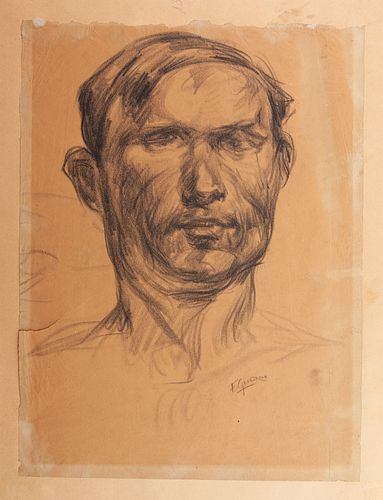FRANCESC GIMENO I ARASA (Tortosa, Tarragona, 1858 - Barcelona, 1927). "Male portrait. Charcoal on paper.
Lot 3
About Seller
Setdart Auction House
Carrer Aragó 346
Barcelona
Spain
Setdart Subastas was born in 2004 and is currently the first online art auction in Spain with solidity, prestige and reliability guaranteed by our more than 60,000 users. Setdart has a young, dynamic and enterprising team ready to successfully manage the purchase and sale of art works through custom...Read more
Categories
Estimate:
EUR€700 - EUR€800
$752.69 - $860.22
Absentee vs Live bid
Two ways to bid:
- Leave a max absentee bid and the platform will bid on your behalf up to your maximum bid during the live auction.
- Bid live during the auction and your bids will be submitted real-time to the auctioneer.
Bid Increments
| Price | Bid Increment |
|---|---|
| EUR€0 | EUR€10 |
| EUR€200 | EUR€25 |
| EUR€500 | EUR€50 |
| EUR€1,000 | EUR€100 |
| EUR€3,000 | EUR€200 |
| EUR€5,000 | EUR€500 |
| EUR€10,000 | EUR€1,000 |
| EUR€20,000 | EUR€2,000 |
| EUR€50,000 | EUR€5,000 |
About Auction
By Setdart Auction House
Nov 10, 2021
Set Reminder
2021-11-10 08:00:00
2021-11-10 08:00:00
America/New_York
Bidsquare
Bidsquare : 19th & 20th Century paintings and Decorative Arts
https://www.bidsquare.com/auctions/setdart-auction-house/19th-20th-century-paintings-and-decorative-arts-7800
Setdart Auction House sofia@setdart.com
Setdart Auction House sofia@setdart.com
- Lot Description
FRANCESC GIMENO I ARASA (Tortosa, Tarragona, 1858 - Barcelona, 1927). "Male portrait. Charcoal on paper. Signed in the lower right area. Measurements: 45,5 x 32,5 cm; 50 x 37 cm (frame). Painter and draftsman, Francesc Gimeno began his training in Tortosa at the age of fourteen. In 1880 he settled in Barcelona and worked as a painter and decorator. At this time, in the face of the undisputed triumph of modernist painting, Gimeno not only kept away from the Catalan artistic environment, but insisted on following in the footsteps of the painters of the Golden Age. Thus, when the usual destination for painters used to be Paris, he traveled to Madrid in 1884. There he worked with Carlos de Haes, master of realist landscape painting, and devoted himself to studying the works of the Prado Museum, especially those of Velázquez. On his return to Barcelona in 1889, he suddenly rejected the contracts offered to him, and devoted himself once again to decorative painting. Gimeno remained almost always on the fringes of the commercial art world. During most of his life, away from official circles, he painted what was closest to him, his family and himself, without ever neglecting the landscape. He participated in some exhibitions, winning prizes such as honorary diplomas in the Barcelona exhibition of 1894 and the National Exhibition of Madrid in 1904, but his works were frequently rejected by the juries. The critics and the public, accustomed to another type of painting, also repudiated his expressive realism, the proletarian theme and his strong and thick brushstroke. Disillusioned, he accentuated his marginalization with respect to the art world and society in general, and that open, passionate and full of illusion young man became a closed, disheveled and self-marginalized man. In spite of everything, Gimeno also had a small circle of admirers. The critic Romà Jori, the painter Ignasi Mallol and the gallery owner Josep Dalmau organized the painter's first solo exhibition in 1915. The exhibition was a critical success and for the first time his artistic work was recognized. This marked the beginning of the artist's last stage; some sponsorships appeared that freed Gimeno from his work as a decorative painter and, from then on, he carried out several landscape campaigns. The recognition of Gimeno's work grew in the last years of his life until it culminated in the homage that, at Christmas 1925, was dedicated to him in the Sala Parés. The MACBA dedicated an exhibition to him in 1978, and in 2006 the Museo Nacional de Arte de Cataluña held the first truly anthological exhibition dedicated to his work. Gimeno is represented in the Prado Museum, the MACBA in Barcelona, the Montserrat Museum, the National Art Museum of Catalonia, the Francisco GodÃa Foundation and the J. Sala collection, as well as in several important private collections. The scenes painted by Gimeno represent the raw reality, without aesthetic concessions, and reveal an extraordinary painter and draftsman. His work, of a direct and transgressive realism, stood out above all for its expressiveness, which dominates over the rest of the plastic values. Gimeno always considered himself as a worker, he never hid his condition of worker, and neither his figure nor his work fit in the bourgeois environments and artistic circles of the time.
- Shipping Info
-
In-house shipping available. Please inquire at admin@setdart.com.
-
- Buyer's Premium



 EUR
EUR CAD
CAD AUD
AUD GBP
GBP MXN
MXN HKD
HKD CNY
CNY MYR
MYR SEK
SEK SGD
SGD CHF
CHF THB
THB













